When you are looking at the best dirt bike helmets that money can buy, no compromises, these 5 helmets all fit the bill.
All of them are at the leading edge of technological advances in recent years. Many of them share the same safety features, each with their own way of dealing with impact forces in a crash.
If you are in the fortunate position to buy the very best available, any of these helmets will do the job they are designed to do exceptionally well, it just comes down to personal preference and which features are most important to you.
All of the helmets in this review are ‘Top of the Line’ and prices range from just under $500 up to $650. If you have just begun riding, or are not in a position to spend that much hard-earned cash just yet on a helmet, there are some excellent helmets in my earlier post: 6 Best Dirt Bike Helmets – Entry level
Quick Summary:
Here’s a quick look at 5 of the Best Dirt Bike Helmets being reviewed here:
- Bell Moto-9 MIPS Helmet – Best Value For Money
- 6D Helmets ATR-2 Helmet – Best Of The Best
- Alpinestars Supertech S-M10 Helmet
- Fox Racing V3 Helmet
- Shoei VFX-EVO Helmet
How To Choose A Dirt Bike Helmet
Top 3 Things To Consider When Purchasing A Premium Dirt Bike Helmet:
1. Protective Features:
Priority number one when purchasing a dirt bike helmet is the level of protection from impacts it gives you in the event of a crash.
As all the helmets in this review are ‘Top of the Line’, each of them is loaded with safety and comfort features. Each manufacturer has taken its own approach to designing what they consider to be the most protective helmet possible.
There have been significant advances in helmet technology in recent years, most notably with dealing with rotational forces on a helmet in an impact.
MIPS (Multi-Directional Impact System) technology is included in helmets from several different manufacturers. Other manufacturers like 6D with their ODS system have taken their own approach to dealing with rotational forces.

Other safety features like breakaway visors, Emergency release cheek pads, clavicle cutaways to protect collar bones (if you don’t use a neck brace) and compression zones at the base of the helmet are being seen on more helmets today.
2. Correct Size and Shape:
All the safety features in the world are wasted if the helmet doesn’t fit properly. Selecting a correctly fitting helmet is essential.
Head SHAPE is just as important as Head SIZE.
Most helmet manufacturers stick to the following head shapes when manufacturing their helmets: Long Oval, Intermediate Oval (This is the most common offered by manufacturers) and Round Oval. It is important to buy a helmet designed for your particular head shape.

For more on selecting the right size and shape: Buying A Dirt Bike Helmet – What You Need To Know
Match your head size with the helmet manufacturer’s size chart to find a match. Each helmet manufacturer will have a different sizing chart, so you will need to follow each brand’s sizing.
I’ve included each manufacturer’s helmet sizing chart here for ease of selection.
3. Ventilation and Comfort:
Plenty of ventilation ports is always a necessity in a dirt bike helmet, even if you don’t always ride in hot weather.
Look for a helmet with entry and exit ports, to allow the flow of air through the channels in the liner of your helmet and allow warm air to exit the rear of the helmet. The general rule is: the more vents, the better.
A liner that is removable for washing and made of moisture-wicking and anti-bacterial fabric is also desirable to keep your helmet fresh.
Let’s look at the Top 5 available for 2020.
1. Bell Moto-9 MIPS Helmet
 Bell is one of the world’s most recognizable helmet names, they’ve been building helmets since 1954, that’s over 60 years of knowledge going into every helmet. The Moto-9 is Bell’s flagship model, used by top MX riders like James Stewart.
Bell is one of the world’s most recognizable helmet names, they’ve been building helmets since 1954, that’s over 60 years of knowledge going into every helmet. The Moto-9 is Bell’s flagship model, used by top MX riders like James Stewart.
Personally, I’ve been using Bell helmets for racing since the Bell Moto 3 as far back as the early ’80s, and can highly recommend them.
The Moto-9, of course, features the MIPS system, a Multi-directional Impact Protection System inside the helmet designed to reduce rotational forces resulting from impacts.
There has been a huge emphasis in this area in recent years with many manufacturers offering their own approach to dealing with rotational forces caused by angular impacts.
MIPS works in a similar way to the brain’s own protective fluid and gives the helmet its own low-friction layer between the EPS and the comfort liner, which absorbs much of the energy created by an angled blow to the head.
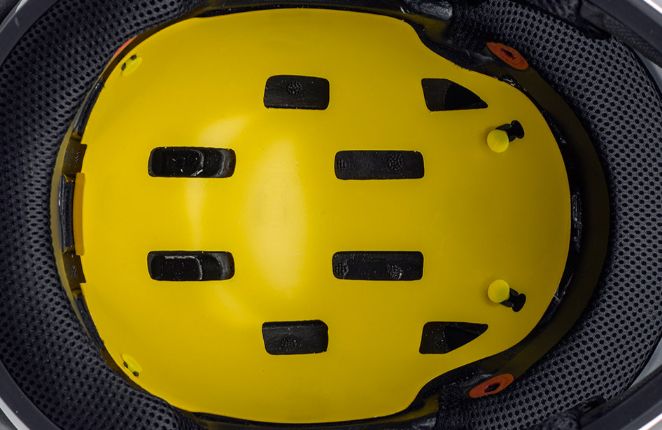
The ‘Tri-Matrix’ shell construction is a mix of Aramid, Carbon fiber, and fiberglass which gives the strength in all the right places and is extremely lightweight. It is available in 3 shell sizes and 3 EPS liner sizes so that you can be sure to get a good fit.
The Velocity Flow Ventilation system gives you multiple intake vents at the front along the chin bar and at the top of the eye-port under the visor, and seven exhaust ports at the back. This is engineered to naturally suck in cool air, channel it over the rider’s head, and exhaust the warm air out of the back vents.
The Moto-9 also features a removable washable comfort liner made with silver-woven antimicrobial and antibacterial material which wicks moisture away from the head and also kills off 99.9% of odor-causing bacteria.
Bell’s Magnefusion Emergency Release System (MERS) uses magnets to allow easy removal of the cheek pads first before removal of the helmet by emergency personal. This minimizes the risk of secondary injury caused by helmet removal in the event of a suspected neck or spine injury.
The Moto-9 is available in 20 different graphics designs, so there’s a style for everyone.
FEATURES
- Fully adjustable Flying Bridge Visor™ with air intake vents
- Fully ventilated EPS-lined chin bar
- Integrated Vented Roost Guard
- Lightweight Composite ‘Tri Matrix’ shell: A proprietary mix of Aramid, Carbon Fiber, and fiberglass which gives the strength of carbon fiber in a more cost-efficient package
- Magnefusion Emergency Release System (MERS): For easy cheek pad removal prior to removal of the helmet by emergency responders
- Magnefusion Magnetic Strap Keeper
- Magnefusion™ Removable Magnetic Cheekpads for ease of washing
- MIPS®️-Equipped: Multi-directional Impact Protection System inside the helmet designed to reduce rotational forces resulting from impacts
- Padded Chin Strap with D-Ring Closure for comfort
- QuickFlip™ visor screws for easy adjustment. Needs no tools
- Removable/washable anti-bacterial interior to keep your helmet fresh
- Velocity Flow Ventilation™ system naturally sucks cool air through the front of the helmet, over the rider’s head and blows warm air out the back for maximum cooling
- X-Static® and XT-2® Silver Liner for odor protection of the liner
- Industry-leading 5-year warranty
SPECIFICATIONS
WEIGHT: 1450 grams approx./3.2 lbs
CERTIFICATION: DOT, ECE, Snell M2015
Pros:
- Good price for a premium helmet
- 5-year warranty
Cons:
- The weight of 1450 grams is not the lightest in its class
- Visor has no release system

2. 6D Helmets ATR-2 Helmet
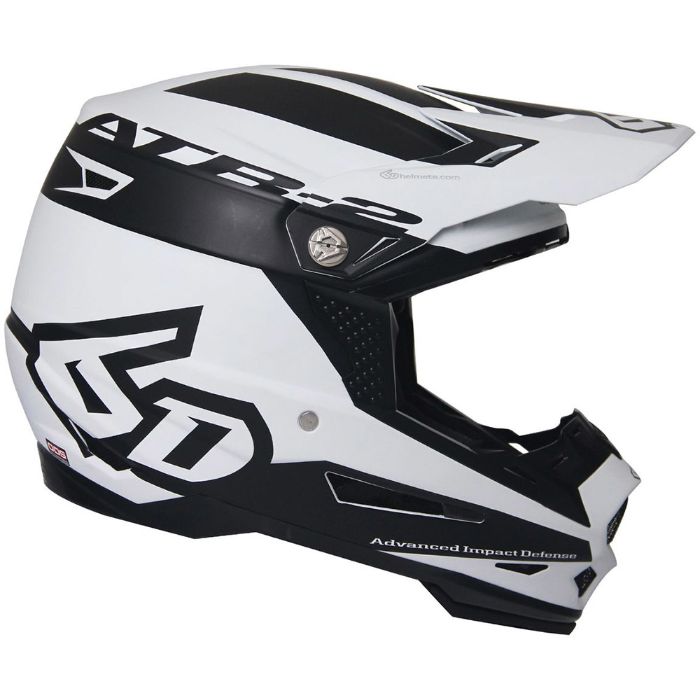 6D is a relative newcomer to the helmet scene. 6d get their name from 6 degrees of rotational impact protection. It is the most expensive helmet in this review but is unique in its innovative technology.
6D is a relative newcomer to the helmet scene. 6d get their name from 6 degrees of rotational impact protection. It is the most expensive helmet in this review but is unique in its innovative technology.
Back in 2012, they came out with the ATR-1 which revolutionized the helmet market and changed the way helmet safety was looked at. It featured two separate EPS liners and 27 isolation dampers within the helmet to help mitigate the angular and rotational forces.
The all-new ATR-2 ODS technology is further evolved and influenced by ODS’ award-winning work in the NFL’s Head Health Challenge III competition. 6D won a $500,000 grant to continue its design research.
The ATR-2 protection has been further advanced in almost every way, but the price has remained the same, so you’re getting even better protection for no extra cost.
They have also managed to shave 100 grams off the weight from the ATR-1, which helps reduce neck fatigue.
The helmet is constructed using 2 separate liners. The inner EPS liner, which is closer to the rider’s head, and the EPP outer liner. Between the liners are 11 isolation dampers and low friction discs.
6D’s dual liner design is like a helmet suspended within a helmet. In an impact, the outer liner moves separately from the inner liner on the ODS and low-friction disk connections. The combination of the two displaces and absorbs the forces during a crash.
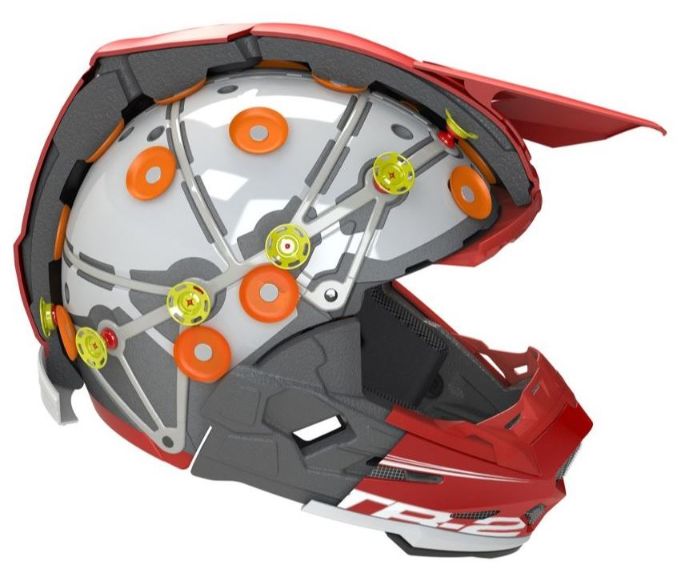
If the helmet’s inner EPS liner is damaged or compressed during a crash, it can be replaced by 6D providing that the outer shell is undamaged. It is a whole lot cheaper than replacing the whole helmet.
The Tri-composite shell is available in 3 different shell sizes. It is an Intermediate Oval fit, which will work for the majority of riders.
It is a DOT, and ECE-rated helmet, so for Dual Sport riders, if you’re riding street and dirt you’re covered.
Ventilation is via 9 intake vents located along the chin bar, at the top of the eye-port, and under the visor. 6 exhaust ports at the rear of the helmet allow the warm air to pass through the helmet.
The adjustable visor is fixed with screws that are designed to shear away in the event of a crash allowing the visor to come off and not cause any additional angular or rotational forces to the rider’s head.
Three other great safety features are located along the bottom edge of the helmet:
At the front under the chin bar is shock-absorbing padding that protects your sternum in the event of your helmet being forced forwards in a crash.
At the sides of the helmet are clavicle cutaways, which help to protect your collar bone from the helmet edge in a sideways movement.
At the rear trailing edge of the helmet is a crushable zone that helps to reduce the chance of spinal injuries from the helmet being forced backward during a crash.
There is even a brow rib above the eye-port to improve the shell strength around the eye-port opening in the event of a frontal impact to the helmet.
Emergency Quick-release cheek pads are also included to aid in helmet removal by emergency responders.
The 6D ODS system even inspired the FIM to create a new mandatory helmet standard for MotoGP road racing.
FEATURES
- Rebuildable Advanced ODS System
- Replaceable inner EPS liner: if it is damaged in a crash, 6D is able to replace it
- Multi-Impact outer EPP liner: at the inner surface of the outer shell
- Progressive EPP Damping Towers to reduce the impact energy
- Low-Friction disks to aid in rotation between liners
- Isolation dampers connect the ODS carrier to the outer EPP line
- Increased ODS (Omni-Directional Suspension) displacement travel (+30%
- Improved linear and angular acceleration mitigation
SHELL
- Optimized lightweight tri-composite shell available in 3 Shell Size
- Cervical protection zone at the lower rear shell area to help reduce spinal injury if the helmet is forced backward
- Brow rib increases shell integrity above the eye-port
- Clavicle cut-aways to protect your collar bone
- 9 intake ports and 6 exhaust ports work in unison with the Air Gap Ventilation System
OTHER HELMET FEATURES
- Removable, washable comfort liner features Genuine Dri-Lex® anti-bacterial fabric
- Emergency Quick-Release cheek pads to aid helmet removal by emergency responders
- PU-Over molded EPP lined chin bar includes 6D’s exclusive Sternum Pad
- Goggle band integrated shell recess at the eye-port area improves goggle fit and seal and prevents strap movement
- Shear-Away visor screws that allow the visor to come off in a crash to avoid further rotational forces
- Nose Guard provides improved roost protection
- Titanium D-Rings for strength and light weight
- 3-year warranty
SPECIFICATIONS
WEIGHT: 1480 grams approx./3.26 lbs (Size Medium)
CERTIFICATION: Exceeds DOT, ECE, AC, and ASTM Standards
Pros:
- Award-winning ODS technology
- Every feature you could ever want
Cons:
- Price is getting up there
- Extra liner thickness makes the overall external size appear larger
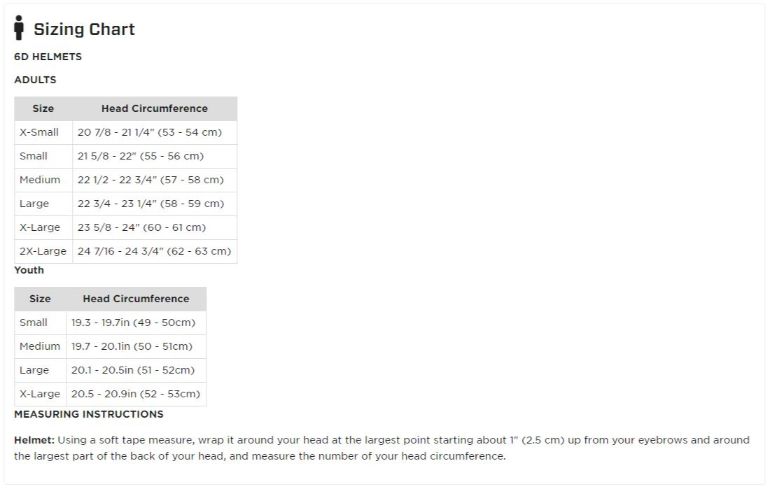
3. Alpinestars Supertech S-M10 Helmet
 With the release of the S-M10 helmet in 2018, Alpinestars has become the only manufacturer in the motorcycle apparel industry to offer complete rider protection from head to toe.
With the release of the S-M10 helmet in 2018, Alpinestars has become the only manufacturer in the motorcycle apparel industry to offer complete rider protection from head to toe.
This is the first time we have seen a helmet from Alpinestars and they have hit the ground running.
The S-M10 has been 5 years in the making with intensive development and testing. Its carbon shell is a multi-composite combination of a 3K high-density carbon outer layer, a UD carbon composite layer, and an Aramid fiber layer.
It comes in 4 shell sizes (small, medium, large and extra-large) and is designed for the Intermediate Oval head shape so it will be suitable for most riders.
It is one of the lightest helmets on the market at only 1260g/2.78 lbs for a medium size. Weight is an important factor in both safety and riding performance. The material selection, preparation, and construction have been analyzed for maximum weight to strength and energy absorption properties.
The multi-density EPS liner’s performance is improved by using 4 different densities of polymer located at different zones around the helmet lining.
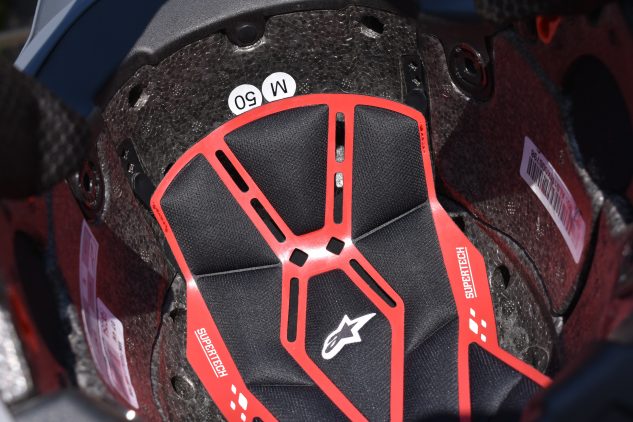
A feature that is unique to the M-10 is the A-Head Adjustment System which allows the helmet’s fit to be fine-tuned to the rider’s preference.
With the micro-adjustable pad that is connected to the helmet’s inner shell, it is possible to raise and lower the helmet fit and also tilt the helmet forward and backward.
MIPS (Multi-directional Impact Protection System) is also incorporated into the helmet to reduce rotational motion energy that impacts the helmet.
The helmet has been designed with maximum ventilation in mind. 19 intake vents channel incoming air through the helmet to keep your head cool, while 5 exhaust vents pull hot air away.
The visor design plays an integral part in the ventilation system, as it’s profiled to direct airflow into the shell. It features a patented mounting/release system that sits flush with the helmet’s shell.
This means that the visor position is not adjustable, but there are no screws, it just snaps into place. It is designed to detach from the helmet at the right level of resistance so that in the event of a crash it does not transmit any rotational forces to the rider’s head. Two visors are supplied with the helmet, regular and Super High.
The M-10 also features an Emergency Release System (ERS) which allows the cheek pads to be easily removed while the helmet is still on the rider’s head. This allows emergency trackside staff to safely remove the helmet and minimizes the risk of secondary injury in the event of a suspected neck or spine injury.
The S-M10 also features a channel along the inside of the chin bar specifically for the tube of your hydration pack, a nice touch.
FEATURES
- Lightweight shell constructed from composite materials
- A-Head Adjustment System: Patented system allows easy adjustment of the angle that the helmet sits on your head.
- Fitted with E-2 latest generation MIPS system
- Multi-density EPS polymer liner in four-section construction for different zones around the helmet
- Visor Release System: Patented system has been developed to provide the right level of resistance to release when needed with impacts from any direction. Two visors supplied
- ERS Emergency Release System for emergency cheek pad removal
- Collarbone Protection: The bottom side of the helmet is raised to clear the collarbone as much as possible for riders who choose not to wear a neck brace system. In addition, the bottom trim is soft on the collarbone area.
- Mouthpiece: To maintain the strength of the mouthpiece, a radial ridge has been incorporated which assures complete strength to the front of the helmet.
- Maximum Ventilation: The interior air network channeling has extremely high ventilation values made possible by the airflow design and the location of all air intakes and outlets. 19 intakes and 5 exhaust vents
- Liner is designed to optimize airflow channeling around the rider’s head. It is a removable and washable cool-max fabric and anti-bacterial
- Chin-Strap: Wider than certification requirement: 26mm for extra comfort with a double D-rings
- Hydration System compatible: Chinbar includes channels on both sides to accommodate hydration system tube
- Additional cheek pad set with increased thickness of +5mm for a tighter fit available separately
- Four Individual Shell Sizes: XS/S, M, L, XL/2XL
SPECIFICATIONS
WEIGHT: 1260 grams/2.78 lbs for size Medium
CERTIFICATION: DOT, ECE
Pros:
- A-Head liner adjustment system is unique
- Lightest helmet in its class
Cons:
- Top vents in chin bar have no screen and can fill with mud quickly
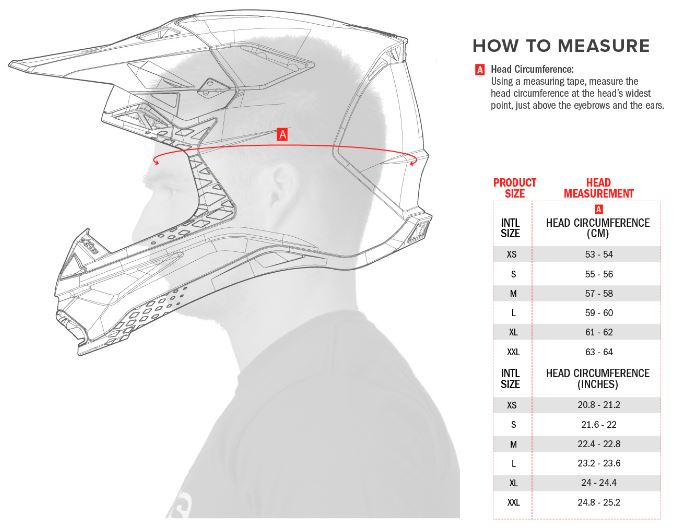
4. 2020 Fox Racing V3 Helmet
Fox Racing is another trusted name in the dirt bike world that has been around for decades. The V3 is Fox’s top-of-the-line dirt bike helmet and is used by top pro motocross riders like Ken Roczen and Ryan Dungy.
The shell is a multi-composite shell that comes in four different shell and EPS liner sizes. It is a neutral to round Oval head shape, so it will work for riders that need a rounder-shaped helmet.
One of the main features of this helmet is the magnetic visor. The second-generation Magnetic Visor Release System or MVRS replaces the 3 screw type fixing and is designed to release from the helmet in the event of a crash and reduce the chance of causing any rotational type forces to the rider’s head.
One of the first things that strike you when looking at the helmet is the massive amount of ventilation at the front of the helmet under the visor and on the chin bar. There are 14 intake and 4 exhaust vents in total.
Fox has changed the way the chin bar is mounted to the helmet with the new CAGE system. It is an injection-molded chin bar that is built separately then fitted to the helmet. It is an extremely rigid chin bar and this means it is able to have a massive amount of ventilation along the chin bar without compromising strength.
It also means that the EPS liner can be injection molded directly into the helmet rather than fitted in after. This is their Varizorb system. The dual-density EPS allows the inner softer layer to absorb the softer impacts, and the harder outer liner absorbs more high-speed impacts.
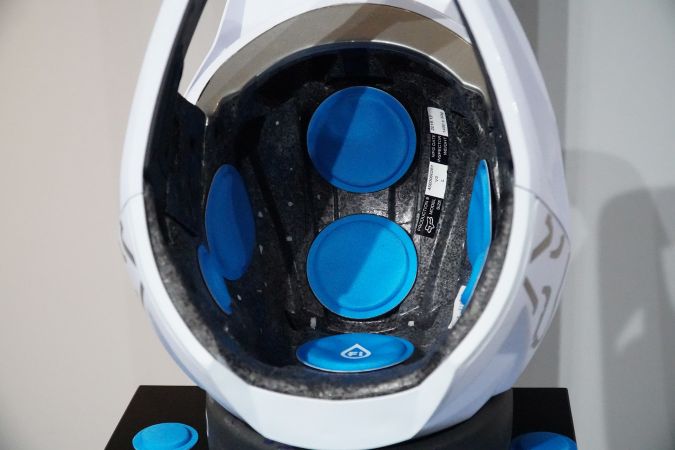
Inside the helmet is the Fluid Inside system. It is designed to mimic your brain’s Cerebral Spinal Fluid – your body’s own natural brain protection.
It is a matrix of fluid pods oriented around the head and attached to the helmet interior. It in effect ‘floats’ the helmet on the head and each fluid pod acts like the Cerebral Spinal Fluid around your brain to manage the linear and rotational forces of an impact. So this is Fox’s take on how to better improve low-speed impact with rotational protection.
The V3 has made some major innovations with the new Magnetic Visor Release System, the new CAGE technology, massive amounts of ventilation, and the Fluid Inside system.
It would have been nice to see an Emergency release cheek pad system and clavicle cutouts like some of the other top-end helmets, but there are a lot of riders out there that are excited about the upgrades in this new version.
FEATURES
- Fluid Inside™: Designed to help dissipate rotational and linear energy transmitted to the rider’s brain in the event of a crash
- Magnetic Visor Release System (MVRS): allows the visor to detach during a crash and mitigate additional rotational forces
- Dual-density Varizorb™ EPS liner: Provides improved protection by spreading the forces of impact across a wider surface area
- Patent-pending chin bar/eye port CAGE™: Designed to improve energy management in the event of an impact
- MCT (Multi Composite Technology) Shell: Blends Carbon and FRP resins to provide a light yet rigid external shell
- 4 shell and EPS sizes to ensure you get the best fit possible
- Injected Mesh vent screens: To provide superior ventilation and airflow, while giving you protection from dirt and debris
- Removable, washable X-Static® comfort liner and cheek pads are antimicrobial and manage odor while wicking moisture away from your head
SPECIFICATIONS
WEIGHT: 1587 grams/3.5 lbs
CERTIFICATION: DOT, ECE 22.05, EN 1078, CPSC 1203, AS/NZS 2063, ASTM F1952
Pros:
- Well priced for a premium helmet
- Massive amount of ventilation
Cons:
- At 1587 grams, the weight is getting up there
- No Emergency release cheek pad system
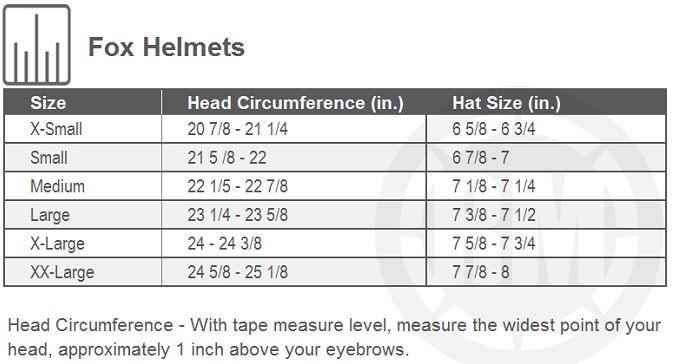
5. Shoei VFX-EVO Helmet
Shoei’s new VFX-EVO helmet has been a long time coming. It’s been nine years since Shoei has come out with an update to its predecessor the VFX-W, and it includes some new technology never seen before in the Japanese company’s 80+ years of making helmets.
It comes in four shell sizes to ensure you get a custom fit, and like most Shoei helmets, it is classified as an Intermediate Oval head shape, so it is suitable for most people.
The Multi-Ply Matrix Aim+ shell is Shoei’s proprietary technology which integrates six-ply construction.
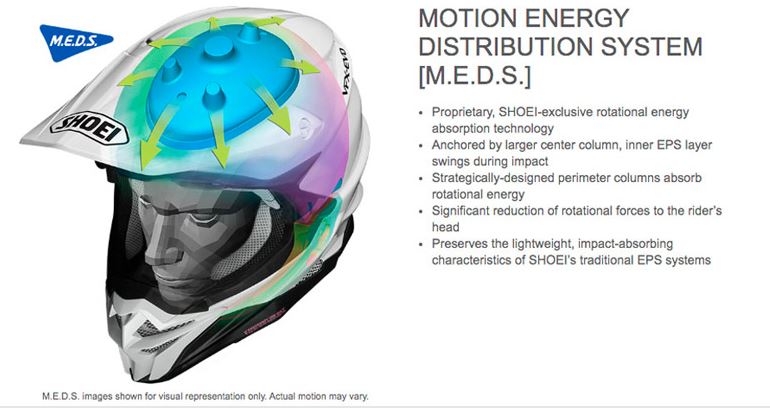
The EVO now features Shoei’s rotational-impact protection system they call Motion Energy Distribution System (M.E.D.S.).
Other helmet companies have similar systems, like the Multi-directional Impact System (M.I.P.S.), or 6D’s O.D.S. system, so it’s good to see helmet technology moving in this direction.
This is Shoei’s first helmet to feature this technology. The design consists of a two-piece EPS liner. A fixed outer layer and an inner layer are anchored together by a center column that swings in the event of an impact, crushing surrounding perimeter columns to absorb energy. Shoei claims a 15 percent reduction in rotational forces to the brain.
The helmet uses a dual-density EPS liner which is softer at the helmet’s crown and firmer at the sides.
Ventilation is handled by 16 intake and exhaust vents which makes this one of the best-ventilated helmets on the market.
The braced nose cover has been designed to improve safety. It features foam mesh to filter out dirt and dust, and an aluminum mesh to prevent roost from getting inside the helmet. All of it is removable for cleaning and maintenance.
The EVO also features their Emergency Quick Release System (E.Q.R.S.) pull tabs to easily remove the cheek pads from the helmet to allow safe removal of the helmet from an injured rider by emergency responders.
FEATURES
- Lightweight fiberglass shell construction
- 4 shell sizes increase fit options that help comfortably fit most head sizes
- Extra front intake vents combine with rear exhaust outlet vents and an enlarged neck outlet vent to maximize flow-through ventilation
- 3D Max-Dry removable liner system material absorbs two times its weight in moisture
- M.E.D.S. (Motion Energy Distribution System) – to take the rotational forces off of impacts
- E.Q.R.S. (Emergency Quick Release System) – special straps under the cheek pads which allow them to be easily removed, so the helmet can be quickly taken off by emergency personnel after an accident
- A larger mouthpiece for improved air intake
- Shell-integrated goggle channel for perfect goggle retention
- Ergonomically shaped mudguard
- Five-year warranty
SPECIFICATIONS
WEIGHT: 1497 grams/3.3 lbs
CERTIFICATION: DOT, Snell M2020
Pros:
- Five-year warranty
- Massive amount of ventilation
Cons:
- The visor has no release system
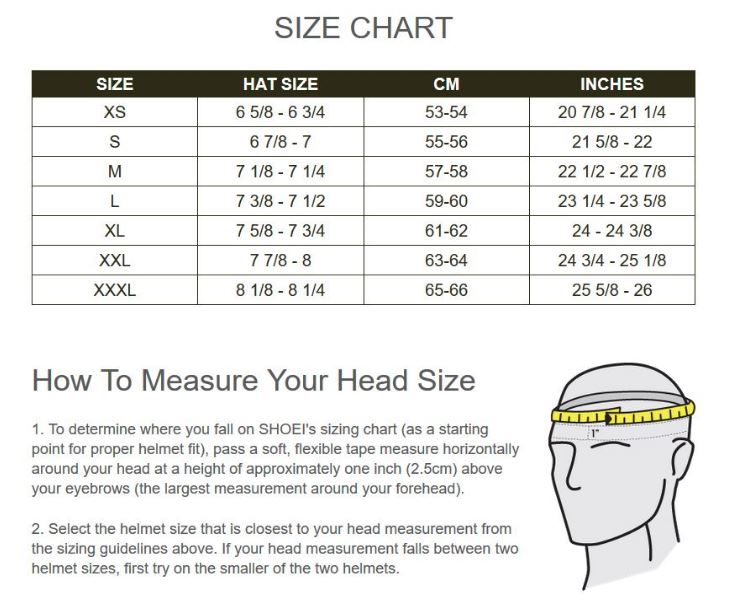
Final Thoughts
It’s a tough job picking the best out of this list, they are all excellent helmets, you would be fine with any one of these, but here are my Top Picks:
Best Value For Money: Only one of these helmets is under the $500 price range but has most of the safety features of the others – the rotational-impact protection system, emergency release cheek pads, composite shell, maximized ventilation, and that’s the Bell Moto 9 MIPS
I’ve owned many Bell helmets over the last 30 odd years, so I have no hesitation in recommending the Moto-9.
Best Of The Best: It’s at the top end of the price range, but has safety features you will find in no other helmet. With its award-winning ODS technology, rebuildable liner, clavicle cutaways, sternum/spine protection, breakaway visor – the list goes on, it has every safety and comfort feature that is available today, all in the one helmet: 6D Helmets ATR-2
With all of this recent helmet technology, MIPS, MEDS, ODS, or similar it is important to realize that it can only go as far as “helping” to reduce the chances of a concussion. Do your research and decide on which one you believe in most. It is the same with neck or knee brace technology, it’s up to you to take in the scientific information and decide for yourself which one you trust the most.
Related Posts
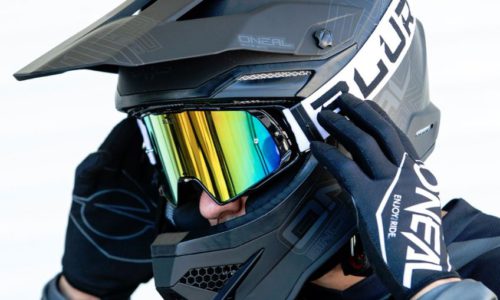 6 Best Dirt Bike Helmets (2020 Update) – Entry Level
6 Best Dirt Bike Helmets (2020 Update) – Entry Level
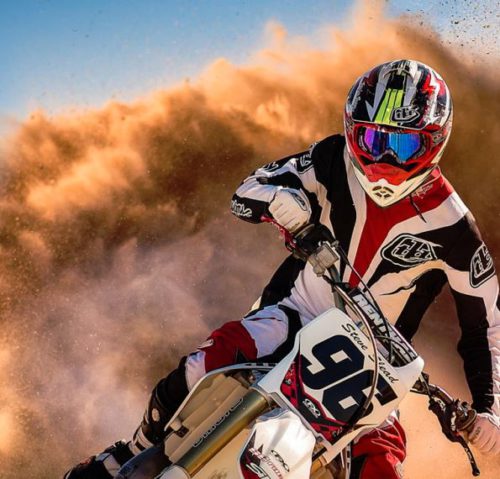
Buying A Dirt Bike Helmet – What You Need To Know
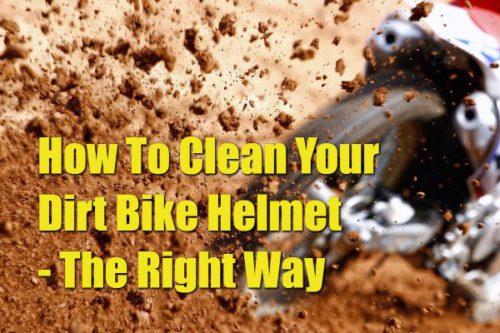
How To Clean Your Dirt Bike Helmet – The Right Way
Have you used any of the helmets in this review? Please feel free to leave any thoughts you have in the comments below.

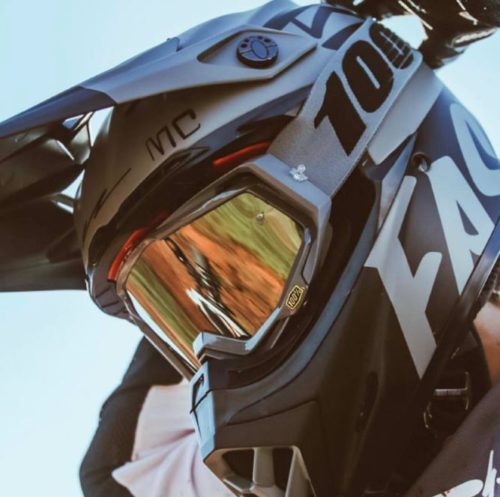

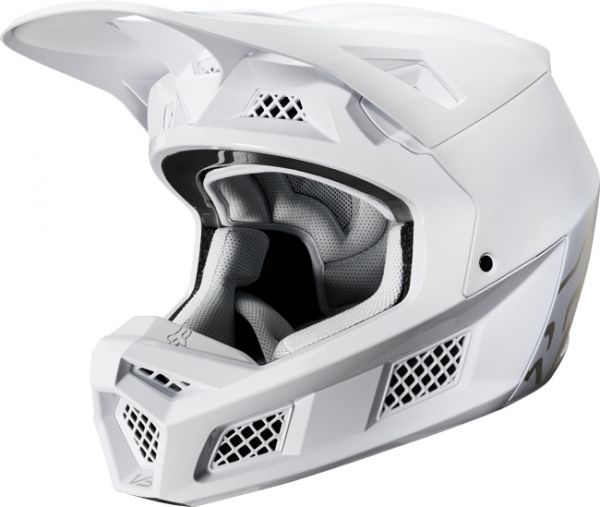
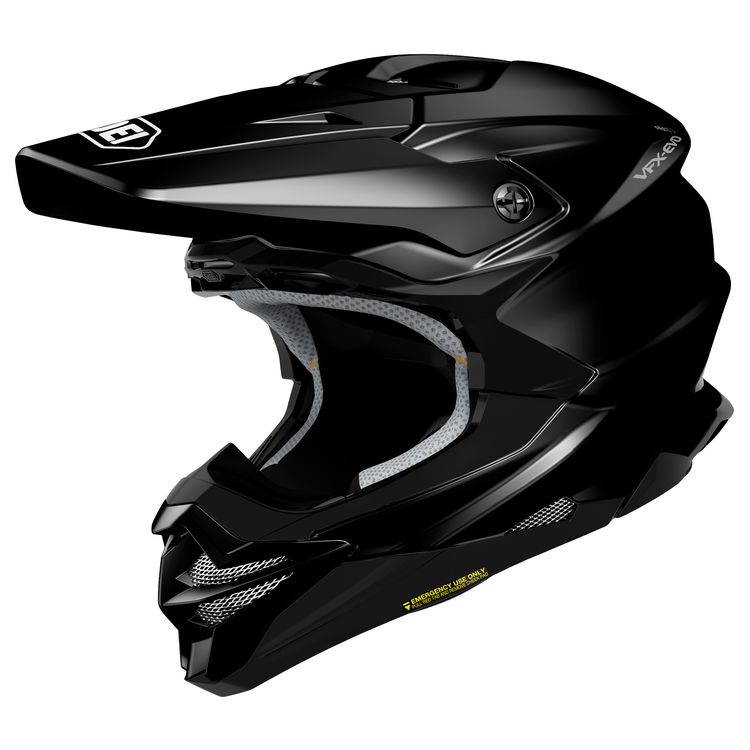
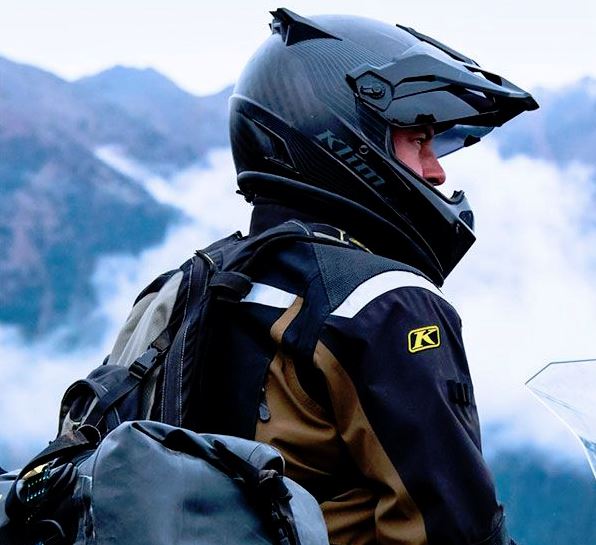
Hi there! This is a very interesting post. I have never owned a dirt bike in the past, but I do know many friends that have. Helmets are a critical part of safety nowadays and they help to avoid concussions, so I think this is an article every rider should read. Thanks for sharing!
Hi Rashaad. Yes, the helmet is every rider’s most important safety equipment, then comes boots. There are so many to choose from with some many features available now, I hope this post will make the decision easier for people. Thanks for dropping in.
Greg
hello, i really want to first appreciate your effort in putting this great website together and writing this article. protection and safety is the first thing to consider when choosing a bike helmet to buy. i must say the 6D ATR -2 helmet is really beautiful. combined with its features it would have been my number 1
Hi Benny. The 6D helmet is revolutionary and award-winning technology. It is at the leading edge of helmet technology today and has every feature you would ever be looking for.
Thanks for your comments.
Greg
Awesome post. All helmets seem great and among all, I was more attracted to 6D Helmets. I believe that helmet should be the thing which requires more and more information. And, most people are unaware of helmets and its quality, unfortunately. The choice of helmets should not be random or cheap. It can save life!
Your post is very informative and all bikers will find it useful. Only thing I want to ask is: I’ve never tried any heavy helmet so far. Have you tried it? Does the heavy helmet affect riding comfort?
Thanks a lot for sharing this useful post.
Cheers
Hi Akshay. Yes, the 6D helmets are best of the best, they have everything you could possibly want.
A heavier helmet does tend to give more neck fatigue after long periods of riding, so obviously a lighter helmet is something to look for. All of these helmets are considered lightweight, the heaviest being the Fox V3 at 1587 grams, but still not excessively heavy. All motocross helmets are generally lighter weight than street helmets.
Thanks very much for this great post about best dirt bike helmets. For really I have enjoyed this article from its start to its end and the different helmets you have provided with their different features, you have made it easier for me to choose one of the best for myself and am getting mine. Thanks in advance.
Hi Mugalu. Glad you enjoyed the post. There is a lot to consider when choosing a helmet these days. When I started riding there was none of the features available – no ventilation, no choice of shell types, no removable and washable liners, the choice was pretty simple. It can be daunting now, so I hope this post makes choosing easier.
Thanks for your comments. Greg
Thank you so much for your 5 best dirt bike helmets for 2020. My nephew is just getting into dirt bikes. When he graduated college a few months ago he went camping with friends and must have been exposed to dirt bikes because now he wants one. I nor his parents, know anything about this sport/activity and I want to make sure I get him the best protection gear possible. In addition to the helmets, are there any other protective gear you could recommend?
Hi Robert. The helmet would be the top priority for protective gear, followed closely by boots.
Here are a couple of links to buying guide articles that I have written:
Buying A Dirt Bike Helmet – What you Need To Know
Dirt Bike Boots Buying Guide – What You Need To Know
Other gear normally used by dirt bike riders includes gloves, riding jersey and pants, chest protector, and knee protectors at a minimum. I have written reviews on all of these. If you would like to know more just look under the Reviews tab on my homepage.
If your nephew is thinking about getting into dirt bikes, this post will be of some help also:
Tips For A Beginner Dirt Bike Rider
If I can be of any more assistance please contact me.
Greg
Hello what Helmet is shown in the first picture?
Hi Anthony. If you’re referring to the helmet in the post title it is the Bell Moto-9 with the ‘Fasthouse’ graphics, which have changed slightly since that version in the picture.
Here is the link on Amazon: Bell Moto-9 Fasthouse
Hope this helps. Greg